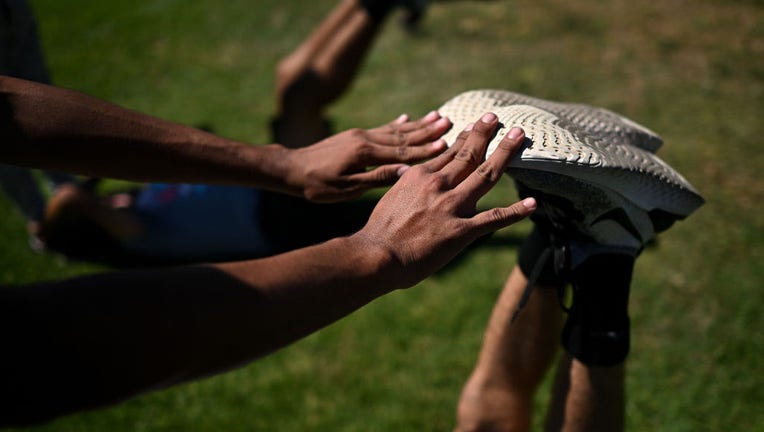75% of US teens aren’t getting recommended daily exercise, particularly females, study finds

FILE IMAGE - Students stretch before a workout at Bell High School on July 1, 2022, in Los Angeles, California. (Wally Skalij/Los Angeles Times via Getty Images)
Three out of every four U.S. teenagers aren’t getting enough exercise, and the issue was found to be even more prominent among females, according to a recent study.
The research, published in the Journal of Adolescence by researchers at the University of Georgia, suggests that improving the environment at school — including a student’s sense of safety and support — could actually play a role in increasing teens’ physical activity.
The study analyzed data from a statewide survey of over 360,000 Georgia high school students. The survey included questions about physical activity levels and school climate, of which there were eight characteristics: school connectedness, peer social support, adult social support, cultural acceptance, physical environment, school safety, peer victimization (bullying), and school support environment.
The study states that 75% of high school students do not meet daily physical activity guidelines. Overall, female students reported less physical activity than their male counterparts, according to the study. Only 35% of females in the survey were active compared to 57% of males, and physical activity declined steadily from ninth grade to 12th grade for both genders.
But students of both genders were found to be more physically active when the school climate was perceived to be positive across most measures, the researchers found.
School can help children develop healthy behaviors, like creating good eating habits. And the same goes for physical activity, according to lead study author Janani Thapa, an associate professor of health policy and management at UGA’s College of Public Health.
"The length of recess, physical facilities, and social environments at schools have been found to affect physical activity among students," Thapa said in a statement published in late June.
How much exercise is recommended for teenagers?
Children and adolescents (ages 6 to 17 years old) are recommended to do 60 minutes or more of "moderate-to-vigorous physical activity" each day, according to guidelines shared by the U.S. Centers for Disease Control and Prevention.
The CDC breaks down the physical activity into three categories: aerobic, muscle-strengthening, and bone-strengthening.
- Aerobic: Most of the 60 minutes or more per day should be either moderate- or vigorous-intensity aerobic physical activity and should include vigorous-intensity physical activity on at least 3 days a week.
- Muscle-strengthening: As part of their 60 minutes or more of daily physical activity, children and adolescents should include muscle-strengthening physical activity at least 3 days a week.
- Bone-strengthening: As part of their 60 minutes or more of daily physical activity, children and adolescents should include bone-strengthening physical activity at least 3 days a week.
Possible link between exercise, students’ school environment
The state of Georgia, along with other U.S. states, has implemented policies and programs to increase physical activity in K-12 schools. Thapa has been one of the lead evaluators of these programs in Georgia.
"Over time, the state has observed declining levels of physical activity among all adolescents, but the rate is higher among female middle and high school students," Thapa said.
The lead study author suspected that the environment at school could play an important role in determining how comfortable students feel participating in school sports or other physical activities. This includes factors such as social support, a sense of safety, and bullying.
"We do not know much about the role of school climate on physical activity," Thapa continued. "There must have been barriers that were faced by certain groups of students. Hence, we wanted to investigate the difference by gender."
The influence of bullying stood out to the study authors, who said it was the only measure of a school’s environment that differed for male and female students. Female students who reported being bullied were more likely to be physically active, while male students who reported being bullied were less likely to be physically active, according to the study.
The study authors noted how this disparity could be explained by the different norms about exercise and masculine versus feminine ideals.
"For example, female students who are active in sports and physically active may not fit the gender norm and hence may face bullying," Thapa said.
The study authors suggested that K-12 schools looking to boost participation in physical activity should consider how to improve students’ sense of safety at school and increase the peer and adult support of exercise.
Internet the ‘default recreational activity’
The study’s findings echo those published previously by the American Heart Association, which also found that only about one in four high school students get the recommended hour a day of physical activity. It warned how teens are missing out on the important health benefits of exercise, which range from a stronger heart to better mental health.
Screen time was partially to blame for the lack of physical activity, the American Heart Association said in a statement shared in April 2020 — which noted how pursuing the internet had become "the default recreational activity."
"There are a lot of social media outlets – it's not just TV and video games anymore," Dr. Geetha Raghuveer, a pediatric cardiologist at Children's Mercy in Kansas City, Missouri, said in the statement. "There is too much tablet (and) computer time and phone time using Facebook and Twitter. There's a great deal of sitting time involved and many detrimental effects associated with this."
Sedentary behavior caused by screens and other factors is prevalent among the U.S. population as a whole. The official physical activity recommendations from the U.S. Department of Health and Human Services indicate that children and adults spend roughly 7.7 hours per day (55% of their monitored waking time) being sedentary and warn of a "substantial" potential population health impact of such behavior.
This story was reported from Cincinnati.



